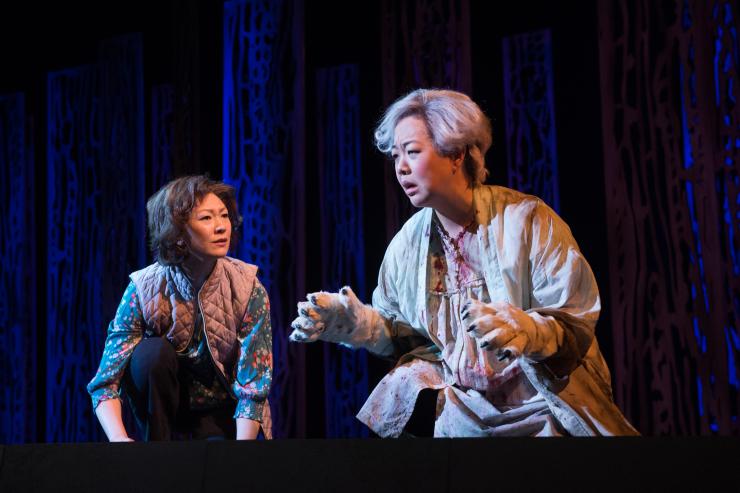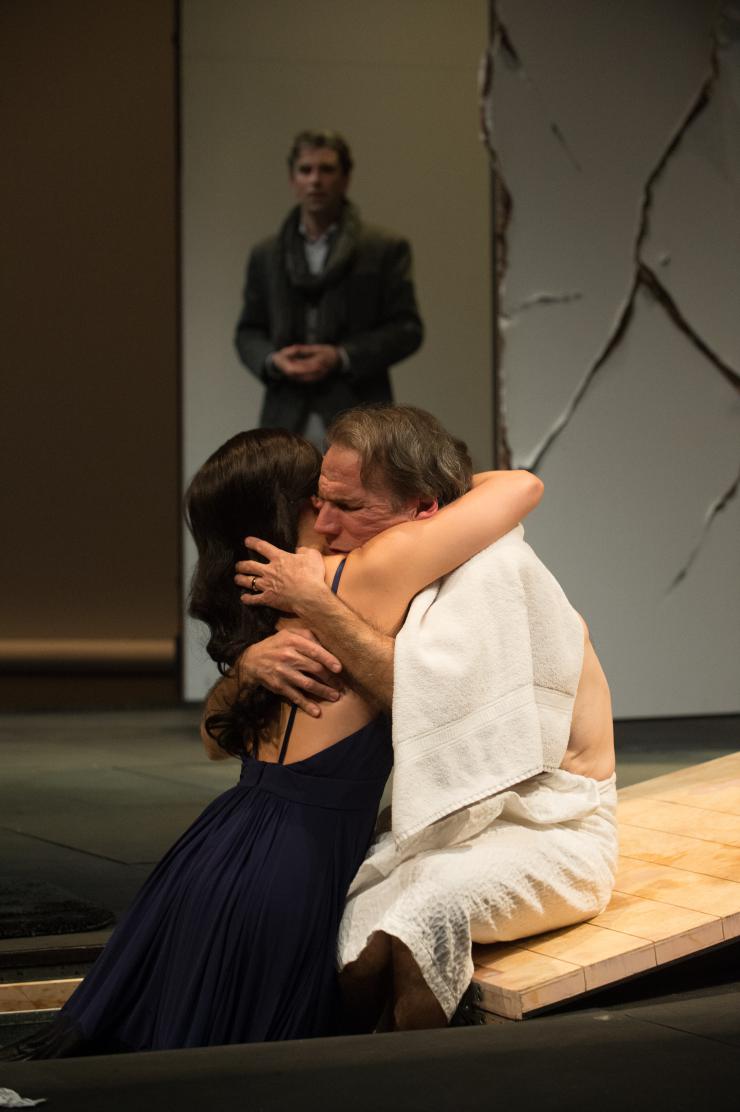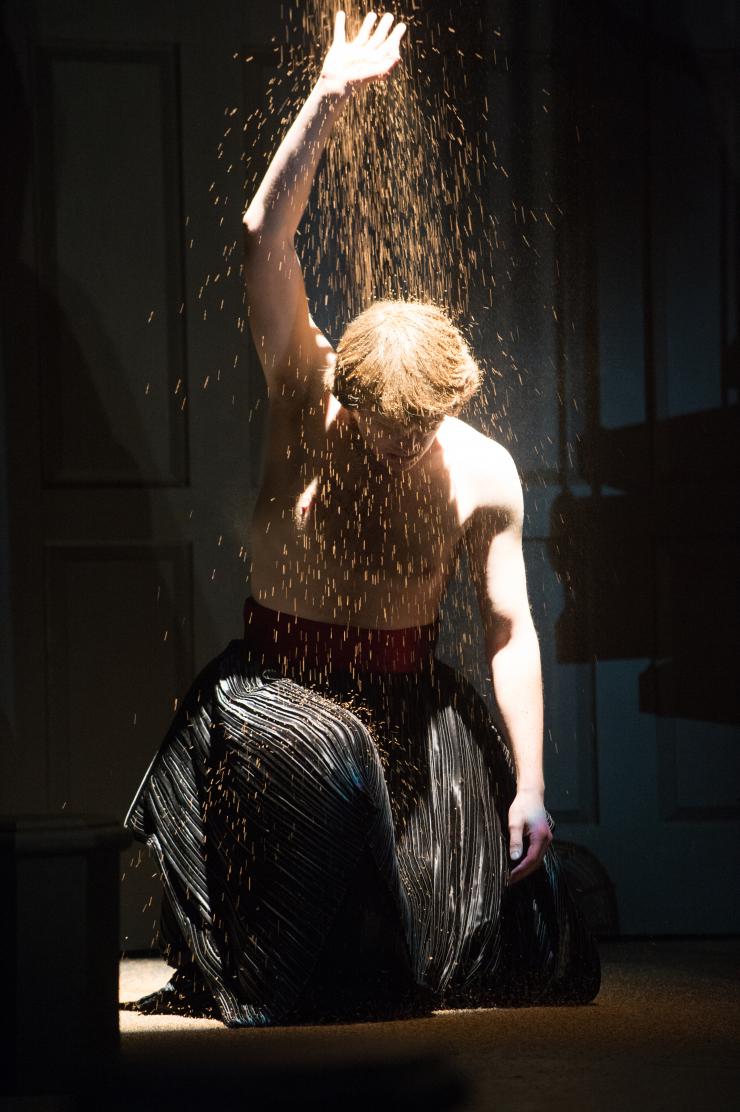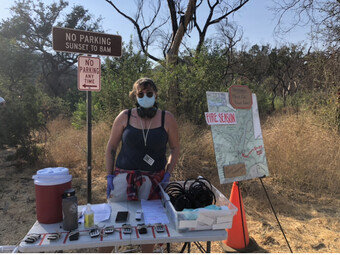Addressing Environmental Topics in Theatre by Using Greenturgy
Diseased nature oftentimes breaks forth
In strange eruptions; oft the teeming earth
Is with a kind of colic pinched and vexed
By the imprisoning of unruly wind
Within her womb, which, for enlargement striving,
Shakes the old beldam earth and topples down
Steeples and moss-grown towers.—Henry IV Part 1 III.i.25-31
August 2017 saw Houston under water, Hurricane Irma headed toward Florida, and large swaths of the Pacific Northwest on fire. In response, the director of the Environmental Protection Agency Scott Pruitt declared that now is not the time to talk about climate change.
In a way, he was right. The time to talk about climate change was decades ago. Now, the greenhouse effect has caused temperatures and sea levels to rise enough that coping with the seemingly endless succession of natural disasters made worse by climate change keeps us too busy to talk much about the underlying causes.
At the Oregon Shakespeare Festival in Ashland, OR, climate is an inevitable topic. This summer, smoke from wildfires burning to the west, south, and northwest occupied the Rogue Valley on and off throughout August and into September, drastically decreasing visibility and often holding unhealthy levels of particulates in the air. As a result, the Festival had to cancel nine performances in its outdoor, twelve hundred-seat Allen Elizabethan Theater.
The man-made contributions to these fires are not hard to parse. According to Paul Barnum, executive director of the Oregon Forest Resources Institute, they include “a century of aggressive fire suppression [leading to the buildup of flammable underbrush] accompanied by discontinued active management of national forests, development near forests, and climate change.”
Thanks to climate change, in July, the Pacific Northwest received less rainfall than normal, leading to drought in parts of Washington and Oregon. At the peak of Oregon Shakespeare Festival’s season, there were fifty-one large, uncontained wildfires in the United States, mostly in the Pacific Northwest. They created enough heat for satellites to detect from space.
[O]nce you begin looking for a way to connect to the environment through the work, you can’t stop seeing environmental issues in everything.
Thankfully, the Oregon Shakespeare Festival is also home to an evolving way of addressing environmental topics through theatre. Concerned about growing human disengagement from the environment, Director of American Revolutions Alison Carey partnered with Literary Director Amrita Ramanan to conceive of “greenturgy.” Loosely structured around four guiding questions, greenturgy aims to excavate environmental concerns embedded in the dramatic canon and new works, using stories to reconnect people to their physical world.
Though OSF has deliberately programmed two environmentally-themed shows for its 2018 season (The Way the Mountain Moved by Idris Goodwin and Snow in Midsummer by Frances Cowhig), the brilliant thing about greenturgy is that you don’t have to be doing plays explicitly about environmental concerns to practice it. In fact, once you begin looking for a way to connect to the environment through the work, you can’t stop seeing environmental issues in everything. The 2017 season’s eleven shows were full of references to the natural world, both in their texts and their productions.
Using greenturgy, you can explore representations of the environment, or the lack thereof, in any production by asking the following questions:
What is the broader environment of our works, whether manifested onstage or not?
What are the parallels between the natural world of the play and where the play is being produced?
What are the environmental impacts of the choices made by characters, intentional, anticipated or otherwise?
What are the connections, literal and metaphorical, between the natural world of our plays and the various natural worlds of our audience?

In Jihae Park’s Hannah and the Dread Gazebo, a second-generation Korean-American woman travels for the first time to Seoul, where her parents have returned, after years living in the United States, to care for Hannah’s grandmother. Hannah’s grandmother, suffering from Alzheimer’s, has nevertheless jumped off the roof of her senior-living facility into the DMZ, where she presumably died. Her body is irretrievable, leaving the family to cope with her death without it.
Hannah’s mother, also feeling suicidal, attempts the same leap, only to trip, hit her head, and fall into a coma. The play veers into the fantastical when we travel inside the comatose Mother’s mind, where she believes that she is trapped in the DMZ.
According to the play, forests in South Korea are at 5 percent of 1910 levels, but within the DMZ, where people cannot go, live Asiatic black bears, Amur leopards, and possibly even white Siberian tigers. This landscape sits in stark opposition to Seoul, where the Mother lives in a high rise, longing for “curb appeal,” a garden, a place to keep the gazebo of the title.
Though the gazebo never appears on stage, the Mother’s trellis is one of very few set pieces we do see in Chay Yew’s imaginative production. In the course of the play, green vines cover this “outside-outside wall,” which the Father even takes to the hospital for the Mother to see when she wakes up.
The DMZ, the mythic tiger, and the trellis all represent the notion that no matter how civilized we get, we always carry with us our essentially natural humanity. Though it’s called Hannah and the Dread Gazebo, it is Hannah’s mother’s journey, her connection to her mother through nature, and her evolving relationship with her daughter that form the heart of this story.
Julius Caesar, directed at OSF by Shana Cooper, evokes a world estranged from nature and yet answerable to it, as well. White walls that split and cracked throughout the production created a sterile environment, which the shedding of so much blood read in relief. And the thunder and lightning that rages the night before the Ides of March, reflecting the Elizabethan belief that dysfunction in the political world is mirrored by dysfunction in the natural world, reminded the audience that civilization never fully supplants nature.

In one of the most vivid scenes in the production, Calphurnia (Amy Kim Waschke) warned Caesar (Armando Durán) not to go the Senate, arguing that the unnatural storm of the night before foretells something bad happening to him: “When beggars die there are no comets seen; / The heavens themselves blaze forth the death of princes” (II.ii.30-31). Set in and around Caesar’s bath, this scene fittingly included the only three-dimensional natural element of the production: Water, into which a fully-dressed Calphurnia plunged in her effort to persuade Caesar to stay at home.
Even in a world in which most people no longer believe that storms are signs from the heavens, the water in this scene was a visceral reminder that even the most powerful men must contend with forces beyond their control. It also connected Calphurnia’s feminine instincts with nature, furthering the production’s conceit that it is the toxically masculine ambitions of men that lead to upheaval, war, and death.

The production in OSF’s 2017 season with the most prominent environmental themes was also the strongest show of the season. Mary Zimmerman’s The Odyssey tells its classic tale with the most minimal of elements but nevertheless evokes a world full of water, earth, and air, controlled by the shifting allegiances of the gods and the hubris of the man at the heart of the journey, Odysseus (Christopher Donahue). The vastness and the terror of the sea looms large in the audience’s imagination without water ever appearing on stage. Billowing costumes suggest blowing, and though many scenes took place upon a beach, sand only appeared at the very end, symbolically representing the deaths of Penelope’s suitors at the hand of her returned husband.
A three-and-a-half hour epic poem, representing the environment as subject to the whimsy of the gods, might seem so outmoded as to impede an audience from making connections to our own present-day environment, but the abstracted representation of the environment on the stage aids the audience to bridge the mental gap between the mythic and the real. We may know that the gods don’t cause storms and that the passage home is not littered with cyclopes, witches, and lotus-eaters, but we also know that despite our best efforts, we do not and never will control nature. No matter how far we roam, our journey home will be one of a return to the earth—ashes to ashes, dust to dust.
OSF…can, both in the work they do and in the way they address the problem of doing outdoor theatre in a changing climate, ensure that their audiences are connected to and thinking about their natural world.
The fires in Northern California and Oregon are out for now, but though the moisture of El Nino provided a summer of respite in 2016, the overall trend in wildfires is not encouraging. According to the Union of Concerned scientists,
Wildfires in the western United States have been increasing in frequency and duration since the mid-1980s, occurring nearly four times more often, burning more than six times the land area, and lasting almost five times as long (comparisons are between 1970–1986 and 1986–2003).
The Oregon Shakespeare Festival is tasked with finding a way to provide entertainment to its audiences even when the very skies are on fire, both as a financial imperative and as a requirement of their social contract with their audience, which has often traveled from across the country to see their shows and cannot return next week. OSF cannot reverse global warming or make up for decades of mismanagement of the forests, but they can, both in the work they do and in the way they address the problem of doing outdoor theatre in a changing climate, ensure that their audiences are connected to and thinking about their natural world. Using greenturgy in their talkbacks, special events, and published materials is one important way to do that.
One of the fires closest to Ashland—the Eagle Creek wildfire—was started by a teenage boy who threw a smoke bomb into a ravine. His conception of his possible impact on the environment was clearly underdeveloped, and not just because of his age. Producing plays with explicitly environmentalist themes is not the only way to address climate change through theatre. Digging up and exposing to the light the presence of the environment in any and every play through greenturgy can also engage communities around the issue, at least enough to help them understand that though they cannot control nature, they can control their personal impact on it.









Comments
The article is just the start of the conversation—we want to know what you think about this subject, too! HowlRound is a space for knowledge-sharing, and we welcome spirited, thoughtful, and on-topic dialogue. Find our full comments policy here
This is terrific work, so necessary! Reminds me of the articles, "There Must Be a Lot of Fish in That Lake" by Una Chaudhuri, and “Beyond Bambi: Toward a Dangerous Ecocriticism” by Theresa May, where among other things she reviews Edward Albee's 'The Goat,' and Lorraine Hansberry's 'A Raisin in the Sun' through an eco-critical lens: "At a time when so many longstanding human endeavors seem to have endangered the integrity of all earth’s species, ecocriticism can expose and dismantle the ideologies and master narratives that shore up business as usual, and inspire performances that help society recalibrate toward sustainable human means. The opportunity as well as the urgency are clear." Bravas!